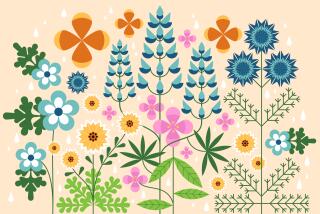GARDENING : Lay Careful Groundwork for Young Plants
- Share via
Annual plants have a time of great fragility as they are getting started. When that time occurs depends on whether they are planted in the ground as seedlings or sown as seeds.
For transplanted seedlings, which will include broccoli, cabbage, peppers, tomatoes, eggplant and a host of annual flowers, the period of vulnerability comes immediately when the small plant is put into foreign ground outside the protection of a pot.
Young seedlings then must hasten to establish a firm foothold in their new environment and, thus stressed for a week or two, are vulnerable to a range of problems.
For varieties that are sown as seed, the delicate period occurs between the sowing and the time the sprouts have established their true leaves, which resemble the leaves of the adult plant. (A seedling’s first leaves typically are oval pairs atop a tall, slim stem.) Depending on soil temperatures at the time of sowing, this vulnerable period might last two to three weeks.
The greatest threats to plants, whether transplanted seedlings or seeds struggling to sprout, are hot, dry winds, burning sun and lack of water.
Here are some suggestions that will help to reduce attrition and get plants and seeds off to a vigorous start in the garden.
* Seed depth. Some seeds won’t germinate if they are covered with too much soil. Seeds that are small, such as carrots, parsley, basil, dill and cilantro, should not be covered too heavily.
When sowing small seeds, mix them with sand, sugar or something else that is light in color so the seeds will be easy to see on the soil surface. Then cover the seeds and lighter-colored material with compost or loose granular garden soil, just enough so all is concealed. Last, press the area with a wide board to ensure maximum contact of the seed surface with soil.
When sowing larger seeds--peas, corn, beans, nasturtium, sweet peas, squash, melon, cucumber--scatter or place the seeds to the correct spacing on the surface of the soil. Beans typically are two inches apart; corn, eight inches.
Then push each seed into the ground with your finger, no farther down than your second knuckle. The idea is to get the seed one to two inches into the ground. Smaller seeds, such as cucumbers, are planted higher; larger ones, such as pumpkins, farther down. Bean and pea seeds sometimes will push up to the surface as they expand with moisture; they should be shoved back under the soil again.
* Seedling depth. The depth at which a young transplant is placed is as important as the seed depth. Nearly all annual varieties respond best to deep planting. Most are single stem, meaning that the plants have a main stem that emerges from the ground and develops leaves somewhere above ground level.
A tomato, pepper or broccoli plant, for example, can be planted six to eight inches into the ground, deep enough, in some cases, that only the top foliage of the original plant is showing above ground. Thus, an eight-inch-tall seedling in a pot becomes a two-inch plant in the garden.
Deep planting accomplishes two things: It helps prevent the seedling from being dried out by wind and sun, and it promotes the growth of roots along the full length of the stem underground, thus anchoring the plant and allowing the maximum amount of nutrients to enter it at many points. The fact that some of the foliage gets buried in the process never seems to set the plant back.
A few plants do not like deep planting. Among annuals, these are the ones that do not display a main stem; rather, their foliage grows in a clump out of the ground. Parsley, chervil, verbena, dahlias, mums and daisies are a few examples.
* Watering. Daily watering is the best way to acclimate seeds or transplants to their new environment. A seed bed should be misted or sprayed very lightly; transplants can be watered by hand with a watering can or a gentle hose. It’s very important to water those first few days.






